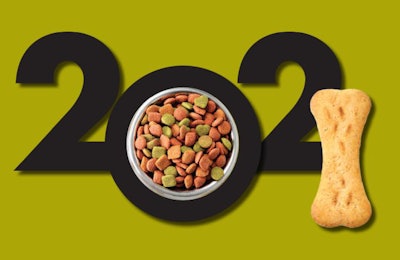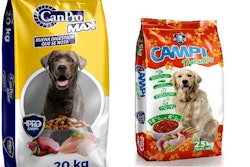
Who would have thought, as we turned the calendar at the end of 2019—with the promise of not only a new year but also a new decade ahead—that we’d have a year like this to experience and endure?
For pet food specifically, the key trends that I and others highlighted to watch in 2020 were seemingly not affected by the year’s major upheavals: a global pandemic, economic downturn, racial unrest and tension-filled elections and their aftermaths. Yet, like every other aspect of life and business, the pet food market itself definitely changed this year, setting up important questions for 2021.
Heightened focus on health, e-commerce
If anything, most of the trends projected for pet food only accelerated in the wake of this year’s crises. Not surprisingly, many of these were also identified for human food, including health and wellness, sustainability and, especially, e-commerce.
For example, the COVID-19 pandemic heightened consumer interest in their immune systems and other aspects of health, and naturally, pet owners extended such concerns to their furry family members, too. In a consumer survey conducted late in 2020 by Packaged Facts, 20% of U.S. dog owners and 21% of cat owners said they were especially concerned about their pets’ immune system health.
Much has already been written about e-commerce and its steady rise before 2020; the year’s events, particularly pandemic-driven shelter-at-home orders and practices, sent the channel into hyperdrive. In a new report from IRI, pet food companies occupied three of the top five spaces among 10 brands ranking highest for sales growth in e-commerce during the year ending November 29, 2020, compared to the same period in 2019. Those companies were Nestlé Purina, Royal Canin and Hill’s Pet Nutrition.
Further, online sales for other pet food companies soared by triple digits: Freshpet grew 186% and C.J. Foods, 167%. Tyson Foods, which has a large pet treats division and also supplies ingredients to the pet food industry, saw 97% e-commerce growth.
With so many consumers now embracing e-commerce, either for the first time in 2020 or further adopting an already regular behavior, it’s predicted to only keep rising, at least through 2025. The same probably holds true, at a lower level, for interest in health and wellness, particularly as the growing fields of nutrigenomics and the microbiome show the benefits of gut and immune health.
Sustainability on the rise despite financial hardship
For several years, discussion about sustainability has noted rising consumer interest in environmentally friendly products and/or from sustainable brands or companies—yet also often an unwillingness for consumers to put their money where their mouth is and actually pay for such products.
One might think that would continue this year, given the financial constraints and hardship so many people are under; however, the opposite appears to have happened. The desire to “buy green” has only increased this year, and in fact now goes beyond green to include social features and claims such as humane treatment of the animals and human workers involved.
This has all converged with a groundswell among businesses, including and perhaps especially in pet food, to embrace sustainability and all its permutations, not only to meet consumer demands but also as a sound and necessary business practice. The momentum will no doubt carry into 2021 and beyond.
Is DCM-gate over?
Writers of columns and opinion pieces have popularized an end-of-year theme called the “pundit audit”: basically, taking stock of one’s predictions at the beginning of the year, celebrating the hits and admitting the misses.
Except perhaps for political pundits who made predictions about elections, I’m not sure this exercise makes any sense for 2020, though admittedly, I’ve attempted to do that here to some extent. And for one topic specific to pet food, I found it very interesting to look back at what I wrote at the beginning of this year: “DCM and grain-free pet food: What will 2020 bring? Let’s hope for continued, comprehensive investigations by FDA and others, plus more discretion with FDA alerts.”
So, what happened with the U.S. Food and Drug Administration’s (FDA) ongoing investigation into cases of canine dilated cardiomyopathy (DCM) and a purported link to grain-free pet food? First, about a month after I posted my thoughts on the situation, a representative from FDA’s Center for Veterinary Medicine (CVM), David Edwards, Ph.D., gave what was supposed to be an update during the American Feed Industry Association’s (AFIA) annual pet food conference. Except that the update was … essentially, there was no update. No news, no announcements anticipated for the near future, nothing.
This was at least a month before COVID-19 hit the U.S. in large numbers. Understandably, that took precedence for every federal agency, including FDA—but it was clear before then that CVM had put the DCM investigation on the back burner.
In fact, the agency issued not another peep about DCM until late October, when it released a communication from an under-the-radar forum it had held in late September, virtually, co-organized by Kansas State University. The several pet food industry experts and representatives who had participated in the forum apparently had been led to believe that CVM did not plan to make any announcements from it; the one it released surprised nearly everyone. (There was also speculation that a blog post about the forum by Ryan Yamka, Ph.D., forced CVM’s hand.)
Even weirder, the focus of the announcement was that it was not an update but an “inflection point” in the investigation, according to CVM’s director, Steven Solomon, DVM. Translation: It was essentially an admission, if not a mea culpa, that the agency had been hasty and careless with its original announcements about the DCM investigation in 2018 and 2019. (Note that this is my interpretation, certainly not CVM’s.) The bottom line is Solomon’s clear statement, “DCM is a complex medical condition that may be affected by the interplay of multiple factors such as genetics, underlying medical conditions and diet.”
Where does that leave us heading into 2021? While studies on DCM and ingredients common to grain-free pet foods are ongoing—and necessary—I for one do not foresee CVM revisiting the issue, at least not voluntarily or in depth. It’s bound to come up at industry events; for example, Edwards is scheduled to speak again at AFIA’s virtual pet food conference on January 26, 2021, and even if he doesn’t address DCM in his presentation, I imagine someone tuning in will ask about it.
Perhaps with all that has happened in 2020, it’s for the best that DCM is no longer top of everyone’s mind. It has become just one of many issues and situations that the pet food industry now needs to track.
View our continuing coverage of the coronavirus/COVID-19 pandemic.


















